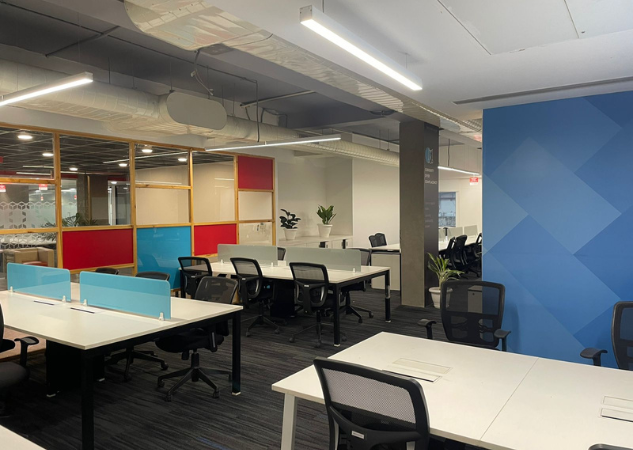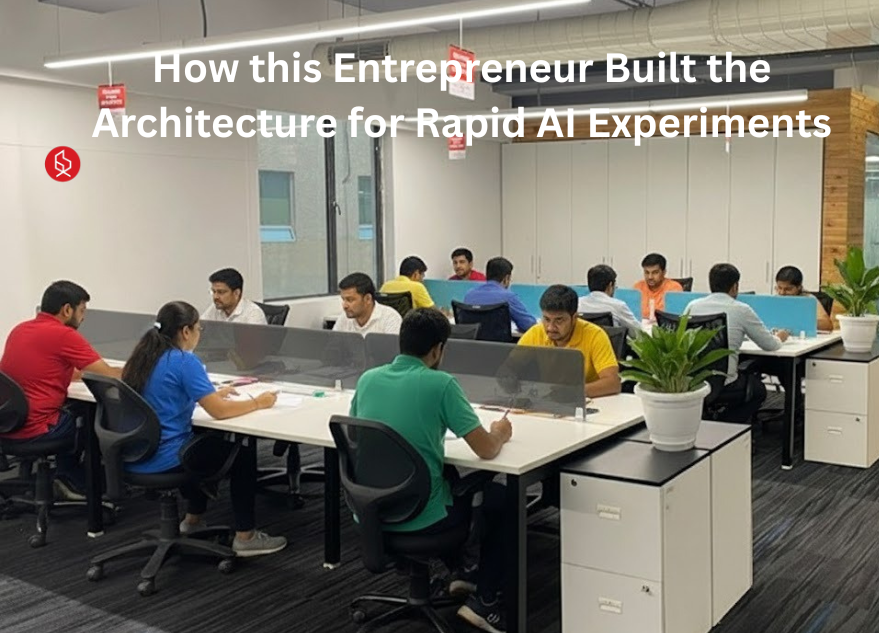In today’s digital world, building AI products means testing ideas fast. This entrepreneur shows how a strong AI architecture enables rapid experimentation, turning concepts into scalable solutions.
💡 Are you looking for Coworking space in Gurgaon, Noida or Delhi? We are just a call away. Call Now: 08999 828282
10 Strategies the Entrepreneur Used to Build an AI Architecture for Rapid Experiments
- Starting Small: The Mindset Behind AI Experimentation
- Designing the Right AI Architecture from Day One
- Building a Streamlined AI Product Development Process
- Choosing the Right Tools for Machine Learning Experimentation
- Automating Data Pipelines for Faster Testing
- Encouraging a Culture of Continuous AI Experimentation
- Leveraging Cloud and Open-Source AI Tools for Startups
- Measuring Success Through Data and Metrics
- Scaling AI Architecture for Real-World Impact
- Lessons Learned: Turning AI Experiments into Sustainable Growth
1. Starting Small: The Mindset Behind AI Experimentation
Every successful AI product begins with experimentation. The entrepreneur adopted a lean testing mindset, focusing on validating ideas through small, quick tests before scaling. This approach reduced the risk of failure and encouraged innovation. In AI experimentation, small, controlled trials help uncover what works and what doesn’t saving time, resources, and effort. This mindset encouraged continuous learning, empowering teams to improve AI models and refine solutions in real time.

2. Designing the Right AI Architecture from Day One
A robust AI architecture is the backbone of every experiment. The entrepreneur designed a flexible, modular system that supported multiple data sources, models, and deployment tools. This made it easier to test, compare, and iterate without starting from scratch each time. By investing early in scalable AI infrastructure, the startup could handle large datasets and automate tasks efficiently creating a strong foundation for sustainable innovation.
3. Building a Streamlined AI Product Development Process
The AI product development process was broken into clear stages: idea generation, data preparation, model design, testing, and deployment. Each stage had measurable goals and review points. This structure made collaboration between data scientists and engineers smoother. By standardizing workflows, the entrepreneur ensured faster turnaround and better accountability. As a result, the company could push AI prototypes from concept to product in record time.
Also Read: Business Terms Every Entrepreneur Should Know By Heart
4. Choosing the Right Tools for Machine Learning Experimentation
Selecting the right tools was critical for speed and accuracy. The team used cloud-based platforms for machine learning experimentation, allowing them to run multiple models simultaneously. Tools like TensorFlow, PyTorch, and MLflow made version tracking and comparison easier. Automating model training and evaluation eliminated repetitive work and reduced human error. This smart use of technology turned experimentation into a daily routine rather than a time-consuming project.
5. Automating Data Pipelines for Faster Testing
Data preparation is often the biggest bottleneck in artificial intelligence implementation. To overcome this, the entrepreneur built automated data pipelines that cleaned, labeled, and stored information consistently. This automation reduced manual work and accelerated AI model training cycles. With clean, reliable data flowing continuously, the team could focus on improving algorithms instead of fixing input issues significantly speeding up every experiment.
6. Encouraging a Culture of Continuous AI Experimentation
Technology alone isn’t enough; culture matters. The entrepreneur encouraged every team member to participate in AI experimentation, regardless of role. Weekly “AI sprint sessions” allowed open discussions about new model ideas, performance results, and improvement plans. This inclusive environment fueled creativity, fostered learning, and made innovation part of daily work life turning challenges into opportunities for growth.
7. Leveraging Cloud and Open-Source AI Tools for Startups
For a startup, cost efficiency is key. The entrepreneur leveraged AI tools for startups open-source libraries and cloud-based machine learning services. This minimized upfront costs while offering access to cutting-edge technologies. Platforms like Google Cloud AI, AWS SageMaker, and Hugging Face provided scalability and flexibility. By combining open-source agility with cloud scalability, the startup could rapidly test and deploy AI solutions without major investments.
8. Measuring Success Through Data and Metrics
Every experiment needs validation. The entrepreneur defined clear performance metrics such as accuracy, speed, and resource cost. These data-driven insights guided decisions during the AI product development process. By continuously monitoring key indicators, the team learned which models were ready for deployment and which needed refinement. Tracking metrics also helped attract investors by showcasing tangible progress backed by data.
💡 Are you looking for Coworking space in Gurgaon, Noida or Delhi? We are just a call away. Call Now: 08999 828282
9. Scaling AI Architecture for Real-World Impact
Once prototypes succeeded, the challenge shifted to scaling. The modular AI architecture allowed seamless integration into real-world systems without disrupting existing processes. The entrepreneur prioritized scalability designing APIs, reusable components, and efficient cloud deployment strategies. This made it easy to expand into new markets, products, or customer segments while maintaining speed and performance.
10. Lessons Learned: Turning AI Experiments into Sustainable Growth
Through this journey, the entrepreneur discovered that innovation is a process, not a one-time event. Building the right architecture, fostering experimentation, and choosing the best AI tools for startups led to long-term success. Each failed experiment became a lesson that guided future growth. This story proves that a structured yet flexible approach to AI experimentation can help startups grow faster, smarter, and stronger.
Rapid AI experimentation is reshaping how modern startups innovate. This entrepreneur’s approach—combining flexible AI architecture, efficient data pipelines, and a culture of curiosity demonstrates how even small teams can create big impact. For aspiring founders, the key takeaway is clear: start lean, test fast, learn continuously, and let data guide your decisions. When you’re looking for the right workspace to support that momentum, The Office Pass (TOP) offers dynamic coworking spaces built for collaboration, innovation, and growth.
Contact TOP now at +91 8999 82 82 82.
Frequently Asked Questions (FAQs)
Question: What is AI experimentation and why is it important?
Answer: AI experimentation involves testing various models, data sets, and algorithms to identify what works best. It’s crucial because it helps reduce risks, improve accuracy, and speed up innovation. By experimenting regularly, startups can discover new solutions faster and make smarter business decisions.
Question: How does AI architecture support experimentation?
Answer: AI architecture provides the foundation for managing data, models, and computational resources. A good architecture allows teams to run multiple experiments simultaneously, integrate new tools easily, and scale efficiently making the entire AI experimentation process faster and more organized.
Question: What are the key stages in an AI product development process?
Answer: The main stages include idea generation, data collection, model building, testing, validation, and deployment. Each step helps ensure that the final AI product is reliable, efficient, and ready for real-world application. A structured process minimizes errors and accelerates development.
Question: How can startups choose the best AI tools?
Answer: Startups should focus on tools that are cost-effective, scalable, and easy to integrate. Open-source libraries like TensorFlow and PyTorch are great for flexibility, while cloud platforms like AWS and Google Cloud AI offer scalability and infrastructure support for AI tools for startups.
Question: What is machine learning experimentation?
Answer: Machine learning experimentation involves testing different models and algorithms to find the most accurate one for a given task. It includes training, validation, and comparison across datasets. This process is key to improving AI systems and ensuring consistent performance.
Question: Why is data automation important in AI development?
Answer: Data automation speeds up artificial intelligence implementation by reducing manual tasks. Automated pipelines clean and organize data efficiently, allowing models to train faster and produce better results. It ensures consistency, reliability, and scalability in AI workflows.
Question: How do entrepreneurs build a culture of AI experimentation?
Answer: By encouraging open collaboration, regular brainstorming sessions, and celebrating both successes and failures. Creating a safe environment for testing ideas motivates employees to contribute and learn—fostering innovation across the organization.
Question: What metrics are used to measure AI experiment success?
Answer: Common metrics include accuracy, precision, recall, processing time, and resource cost. Tracking these helps determine whether an AI model meets its goals or requires improvement. Data-driven evaluation makes AI experimentation more objective and transparent.
Question: Can small startups afford to build advanced AI systems?
Answer: Yes. With open-source frameworks and cloud-based AI tools for startups, even small teams can build powerful AI systems. Many services offer pay-as-you-go pricing, enabling startups to scale affordably as their business grows.
Question: What’s the biggest lesson from this entrepreneur’s journey?
Answer: The key lesson is that success in AI comes from structure and speed. A strong AI architecture, combined with continuous AI experimentation, helps startups innovate rapidly while minimizing costs. Learning from failures and adapting quickly ensures lasting growth.



